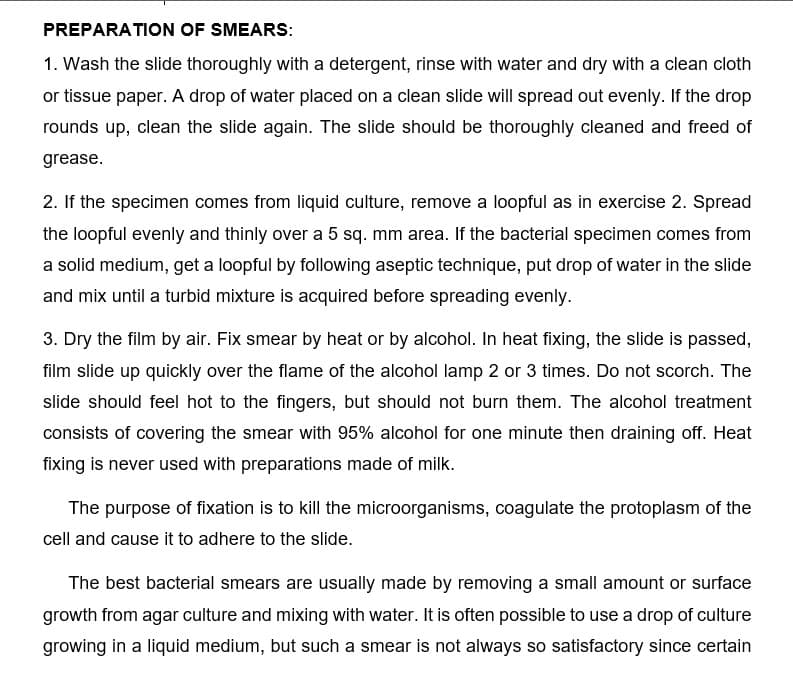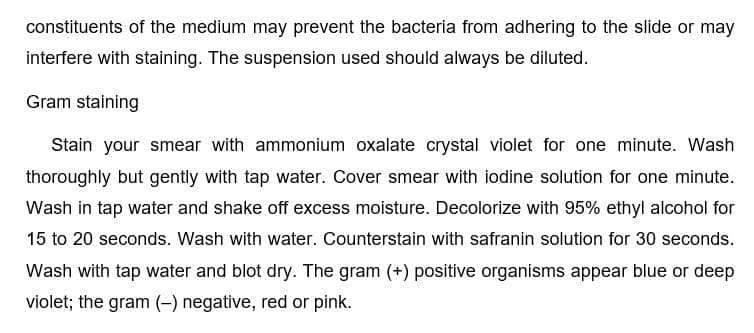PREPARATION OF SMEARS: 1. Wash the slide thoroughly with a detergent, rinse with water and dry with a clean cloth or tissue paper. A drop of water placed on a clean slide will spread out evenly. If the drop rounds up, clean the slide again. The slide should be thoroughly cleaned and freed of grease. 2. If the specimen comes from liquid culture, remove a loopful as in exercise 2. Spread the loopful evenly and thinly over a 5 sq. mm area. If the bacterial specimen comes from a solid medium, get a loopful by following aseptic technique, put drop of water in the slide and mix until a turbid mixture is acquired before spreading evenly. 3. Dry the film by air. Fix smear by heat or by alcohol. In heat fixing, the slide is passed, film slide up quickly over the flame of the alcohol lamp 2 or 3 times. Do not scorch. The slide should feel hot to the fingers, but should not burn them. The alcohol treatment consists of covering the smear with 95% alcohol for one minute then draining off. Heat fixing is never used with preparations made of milk. The purpose of fixation is to kill the microorganisms, coagulate the protoplasm of the cell and cause it to adhere to the slide. The best bacterial smears are usually made by removing a small amount or surface growth from agar culture and mixing with water. It is often possible to use a drop of culture growing in a liquid medium, but such a smear is not always so satisfactory since certain
PREPARATION OF SMEARS: 1. Wash the slide thoroughly with a detergent, rinse with water and dry with a clean cloth or tissue paper. A drop of water placed on a clean slide will spread out evenly. If the drop rounds up, clean the slide again. The slide should be thoroughly cleaned and freed of grease. 2. If the specimen comes from liquid culture, remove a loopful as in exercise 2. Spread the loopful evenly and thinly over a 5 sq. mm area. If the bacterial specimen comes from a solid medium, get a loopful by following aseptic technique, put drop of water in the slide and mix until a turbid mixture is acquired before spreading evenly. 3. Dry the film by air. Fix smear by heat or by alcohol. In heat fixing, the slide is passed, film slide up quickly over the flame of the alcohol lamp 2 or 3 times. Do not scorch. The slide should feel hot to the fingers, but should not burn them. The alcohol treatment consists of covering the smear with 95% alcohol for one minute then draining off. Heat fixing is never used with preparations made of milk. The purpose of fixation is to kill the microorganisms, coagulate the protoplasm of the cell and cause it to adhere to the slide. The best bacterial smears are usually made by removing a small amount or surface growth from agar culture and mixing with water. It is often possible to use a drop of culture growing in a liquid medium, but such a smear is not always so satisfactory since certain
Microbiology for Surgical Technologists (MindTap Course List)
2nd Edition
ISBN:9781111306663
Author:Margaret Rodriguez, Paul Price
Publisher:Margaret Rodriguez, Paul Price
Chapter3: The Microbiology Laboratory
Section: Chapter Questions
Problem 1TBP
Related questions
Question
Make a flowchart for the PREPARATION OF SMEARS

Transcribed Image Text:PREPARATION OF SMEARS:
1. Wash the slide thoroughly with a detergent, rinse with water and dry with a clean cloth
or tissue paper. A drop of water placed on a clean slide will spread out evenly. If the drop
rounds up, clean the slide again. The slide should be thoroughly cleaned and freed of
grease.
2. If the specimen comes from liquid culture, remove a loopful as in exercise 2. Spread
the loopful evenly and thinly over a 5 sq. mm area. If the bacterial specimen comes from
a solid medium, get a loopful by following aseptic technique, put drop of water in the slide
and mix until a turbid mixture is acquired before spreading evenly.
3. Dry the film by air. Fix smear by heat or by alcohol. In heat fixing, the slide is passed,
film slide up quickly over the flame of the alcohol lamp 2 or 3 times. Do not scorch. The
slide should feel hot to the fingers, but should not burn them. The alcohol treatment
consists of covering the smear with 95% alcohol for one minute then draining off. Heat
fixing is never used with preparations made of milk.
The purpose of fixation is to kill the microorganisms, coagulate the protoplasm of the
cell and cause it to adhere to the slide.
The best bacterial smears are usually made by removing a small amount or surface
growth from agar culture and mixing with water. It is often possible to use a drop of culture
growing in a liquid medium, but such a smear is not always so satisfactory since certain

Transcribed Image Text:constituents of the medium may prevent the bacteria from adhering to the slide or may
interfere with staining. The suspension used should always be diluted.
Gram staining
Stain your smear with ammonium oxalate crystal violet for one minute. Wash
thoroughly but gently with tap water. Cover smear with iodine solution for one minute.
Wash in tap water and shake off excess moisture. Decolorize with 95% ethyl alcohol for
15 to 20 seconds. Wash with water. Counterstain with safranin solution for 30 seconds.
Wash with tap water and blot dry. The gram (+) positive organisms appear blue or deep
violet; the gram (-) negative, red or pink.
Expert Solution
This question has been solved!
Explore an expertly crafted, step-by-step solution for a thorough understanding of key concepts.
Step by step
Solved in 2 steps with 2 images

Knowledge Booster
Learn more about
Need a deep-dive on the concept behind this application? Look no further. Learn more about this topic, biology and related others by exploring similar questions and additional content below.Recommended textbooks for you

Microbiology for Surgical Technologists (MindTap …
Biology
ISBN:
9781111306663
Author:
Margaret Rodriguez, Paul Price
Publisher:
Cengage Learning

Comprehensive Medical Assisting: Administrative a…
Nursing
ISBN:
9781305964792
Author:
Wilburta Q. Lindh, Carol D. Tamparo, Barbara M. Dahl, Julie Morris, Cindy Correa
Publisher:
Cengage Learning


Microbiology for Surgical Technologists (MindTap …
Biology
ISBN:
9781111306663
Author:
Margaret Rodriguez, Paul Price
Publisher:
Cengage Learning

Comprehensive Medical Assisting: Administrative a…
Nursing
ISBN:
9781305964792
Author:
Wilburta Q. Lindh, Carol D. Tamparo, Barbara M. Dahl, Julie Morris, Cindy Correa
Publisher:
Cengage Learning


Understanding Health Insurance: A Guide to Billin…
Health & Nutrition
ISBN:
9781337679480
Author:
GREEN
Publisher:
Cengage


Principles Of Radiographic Imaging: An Art And A …
Health & Nutrition
ISBN:
9781337711067
Author:
Richard R. Carlton, Arlene M. Adler, Vesna Balac
Publisher:
Cengage Learning